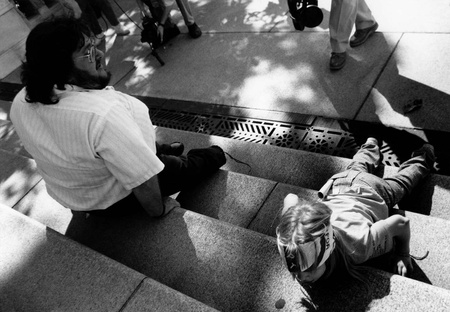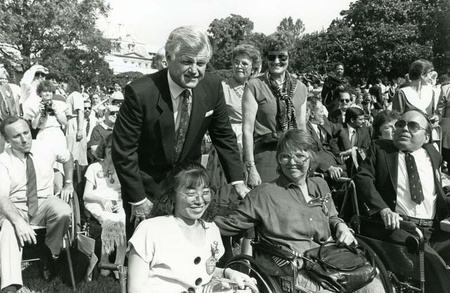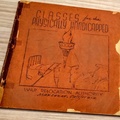The Americas with Disabilities Act
Decades later, Inouye and Matsunaga became Senators.
They joined Congressman Matsui, and Congressman Norman Mineta—whose family had been incarcerated at Heart Mountain1—in supporting the Americans with Disability Act (ADA). Additionally, many civilians were also involved in the movement, including Justin and Yoshiko Dart, as well as Michael Winter and Atsuko Kuwana. Yoshiko and Atsuko are first generation Japanese-Americans. Both Kuwana and Winter use wheelchairs: Kuwana due to a spinal cord injury at birth and Winter due to osteogenesis imperfecta (or brittle bone disease).2
The Darts would help start the movement and Winter and Kuwana would help finish it. Justin, who contracted polio as a teen, became the “father of the Americans with Disabilities Act". In 1981, President Ronald Reagan appointed Justin as the vice-chair of the National Council on Disability. The Council would create a policy proposal to end disability discrimination, which would become the ADA framework.3
In 1988, he was appointed chair of the Congressional Task Force on the Rights and Empowerment of Americans with Disabilities. He and Yoshiko toured the country advocating for the ADA. They met citizens in every state, Puerto Rico, Guam, and D.C. and held public forums that drew more than 33,000 people. They met congress members and their staff, President Bush, Vice President Quayle, and Cabinet members to gather support.4
Yoshiko later called the disability rights movement "Magnificent. It might be one of the last frontier movements in human development.”5
Unlike the others, Mineta did not have any personal connection to disability, but rather became involved with disability rights through a friend while running for San Jose mayor:
“I had a friend working on my campaign named Bill Poole, who'd been in a wheelchair all his life. One day he asked me whether I would consider spending my first week as mayor in a wheelchair….I put a wheelchair in my trunk each morning, and quickly realized how difficult things were for Bill and people with disabilities. I couldn't get up the stairs to City Hall. I couldn't go to the bathroom. I couldn't get a drink from the public fountain.”6
This experience led Mineta to work on the transportation portion of the ADA. At the subcommittee hearing in 1989, Mineta explained that, “Many disabled individuals have cited a lack of transportation as the chief barrier to full participation in their communities.”7
But their support and campaigning were not enough. When the bill failed, Kuwana was one of the “more than 8,500 citizens with disabilities, [along with] their advocates and organizations from every state who signed and paid their scarce dollars to sponsor this petition for justice,” who urged the House to pass the bill in February 1990.8
A month later, Winter participated in the Capitol Crawl. On March 12, he and other activists, including 8-year-old Jennifer Keelan, got out of their wheelchairs and crawled up the front steps of the Capitol building.9

Their efforts paid off and the bill move to the Senate. At the hearing, Daniel Inouye said that July 13, 1990, “will mark one of the greatest accomplishments of the 101st Congress” and in signing the ADA, “Washington signals a new beginning for 43 million Americans with physical and mental disabilities…”
Quoting Senator Tom Harkin who introduced the bill, Inouye called it,
“nothing less than an ‘emancipation proclamation’ for people with disabilities who will finally benefit from civil rights protections in the areas of private sector employment, State and local public services, public and private transportation services, privately owned public accommodations, and telecommunications relay systems.”10
The Darts and Atsuko Kuwana were at the White House when President Bush signed the ADA into law on July 26, 1990. Justin sat beside President Bush and is captured in the famous photograph. Bush later sent a signed copy to the Darts with a note.

Yoshiko took many pictures, including one of Kuwana with Senator Ted Kennedy and other activists after the signing. Michael Winter would serve as “a key adviser” to Transportation Secretary Mineta from 2001 to 2006.11

The Aftermath
At the state level, Washington legislator Kip Tokuda, Floyd’s brother, advocated for many disabled people including those with developmental disabilities. After the ADA passed, he sponsored the “an Act relating to supported employment for persons with developmental disabilities” and “Act Relating to dog guides and service animals” to amend Washington laws “related to guide and service dogs [which] is inconsistent with the Americans with Disabilities Act.” He was also instrumental in passing the “Special Needs Adoption” bill.12
Others enforced the ADA as private citizens. In Oregon, architect Kenneth Takao Nagao “worked for the city of Eugene and other nearby cities, inspecting schools and municipal buildings for handicap accessibility and compliance.”13
Thirty years later, there is still much to be done, and the next generation continues to fight. Rosemary McDonnell-Horita, who has brittle bone disease, still struggles to get around. While helping organizations increase accessibility for their space and programs, she still has to make sure that businesses can accommodate her wheelchair. Even now, she says, “There’s still a lot of stigma, there are still a lot of people who think people with disabilities are helpless. A lot of people remain unaware.”14
But there is some progress during the current health crisis. McDonnell-Horita notes that the transition online has made it easier for some people with autism to participate. Also, as part of its outreach, the Clyfford Still Museum began weekly webinars and classes, and “without being asked they made sure the webinars were closed captioned…[which] allows people to join in without having to plan, without having to ask for it in the first place.”15
Atsuko Kuwana and her son returned to her hometown in Japan annually to visit her family. In 2003, she spoke at an elementary school and shared her experiences. One of the questions students asked was “What is the difference between Japan and America [with regard to disability access]?” Kuwana replied,
“In America there are laws that protect people with disabilities so they can live and work together with people who don’t have disabilities. Buildings must have ramps and elevators and accessible toilets. It’s against the law to discriminate against people with disabilities. If some place isn’t accessible, we can use those laws to ask for changes. That’s a big difference.”16
I recently got in touch with Yoshiko Dart and Atsuko Kuwana who have been enthusiastic and supportive of my research and writing. Atsuko and I had a wonderful, long conversation about her activism, her family, and her adopted son’s struggles with being Japanese American in a mixed race family, struggles which mirrored my own. I look forward to a more in-depth conversation with Atsuko soon.
Notes:
1. History, Art & Archives. “Internment | US House of Representatives: History, Art & Archives.” Accessed December 1, 2021.
2. Fay, Fred, and Fred Pelka. “Famous (and Not-so-Famous) People with Disabilities - Justin Dart,” June 22, 2002.
“1990 – Washington – Michael Winter,” April 30, 2017.
Kittaka, Louise George. “Atsuko Kuwana: Jumping in at the Deep End.” The Japan Times, August 24, 2019. .
3. Fay, Fred, and Fred Pelka. “Disability Rights Hero Completes His Mission: Justin Dart Obituary” Ability Magazine, June 22, 2002.
Olmstead Rights. “The Americans With Disabilities Act of 1990 - ADA.” Accessed December 1, 2021.
4. Fay, Fred, and Fred Pelka. “Famous (and Not-so-Famous) People with Disabilities - Justin Dart,” June 22, 2002.
5. The Emancipation Proclamation for the Disabled. “Yoshiko Dart.” Accessed December 1, 2021.
6. Cannon, Carl M. “Longest-Serving Transportation Secretary Discusses Career.” Government Executive, July 21, 2006.
7. History of Public Law 101-336, the Americans with Disabilities Act: Prepared for the Committee on Education and Labor, U.S. House of Representatives, One Hundred First Congress, Second Session. Washington D.C.: U.S. Government Printing Office, 1990.
8. “A Message to Congress from Representatives of 43 Million Amerians with Disabilities.” Washington Post. February 7, 1900.
9. Jennifer Keelan-Chaffins. “Jennifer Keelan-Chaffins.” Accessed December 1, 2021.
Barnes, Bart. “Michael Winter, Advocate for Disability Rights; at 61.” Boston Globe. August 17, 2013.
10. United States of America Congressional Record Proceedings and Debates of the 110th Congress Second Session Volume 154-Part 10. Washington, D. C.: Government Printing Office)
Congressional Record—Senate. Friday, July 1990
11. ENDependence Center of Northern Virginia. “Pictures from the Past: ADA 25th Anniversary,” July 9, 2015.
12. Certification of Enrollment Substitute Senate Bill 5768 .April 22, 1997.
House Bill Analysis HB 1491. February 11, 1997.
Council Connection. “Remembering Kip Tokuda.” Accessed August 2, 2020.
“Former Washington State Lawmaker Kip Tokuda Dies at 66.” Rafu Shimpo. July 18, 2013.
13. “Kenneth Takeo Nagao Obituary,” Visitation & Funeral Information. Accessed December 1, 2021.
14. Rockett, Caitlin. “Is This Working for Everybody?” Boulder Weekly. May 21, 2020.
“Meet Rosie McDonnell-Horita.” Accessed July 17, 2020.
15. Rockett, Caitlin. “Is This Working for Everybody?” Boulder Weekly. May 21, 2020.
16. Gordenker, Alice. “Guest Teachers Build Barrier-Free Minds,” The Japan Times. July 31, 2003.
*This article is a slightly expanded version of the original, published on the Disability History Association’s AllOfUs blog in November 2020 for the 30th anniversary of the Americans with Disabilities Act.
© 2021 Selena Moon



